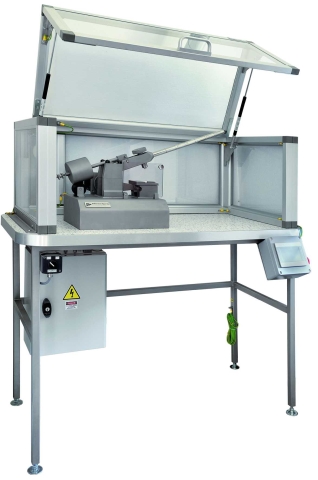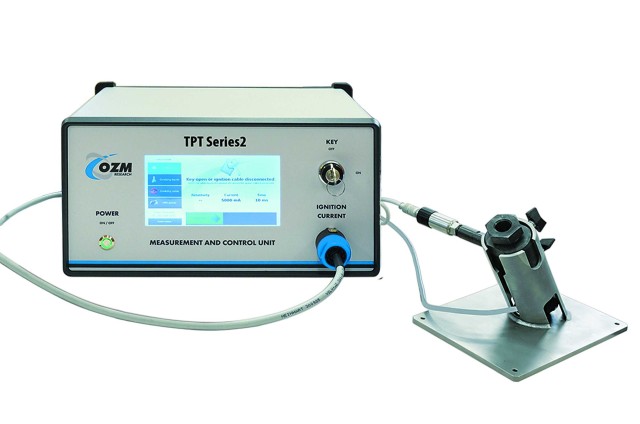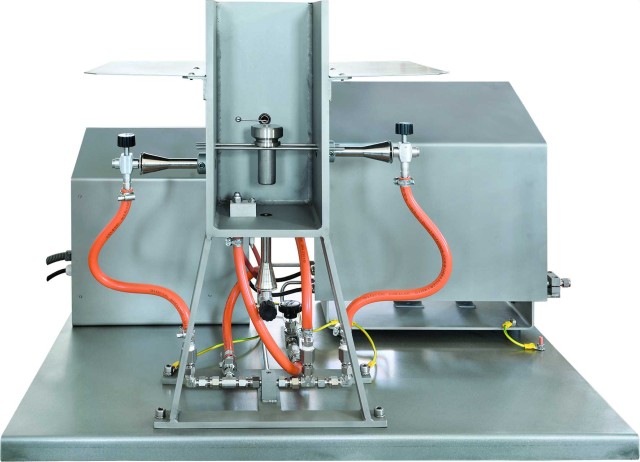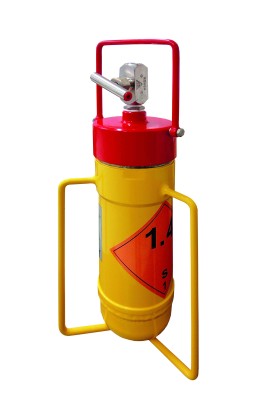Research and development of new Explosive Materials (EM) usually require the most extensive testing program. The initial formulation of EM can start with the EXPLO5, a thermochemical program for the calculation of explosion parameters of new substances and mixtures.
Experimental testing of newly developed EM typically begins with small-scale (sub gram-scale) sensitivity to external stimuli tests:
impact (BFH Series), friction (FSKM 10) and electrostatic spark (X SPARK 10) for the characterization of their safety risks in handling.
Sensitivity testing of highly sensitive primary explosives pose special challenges because their sensitivity levels are typically in orders of the magnitude higher than that of other EM classes. This is why our instrumentation is either developed specifically for testing these very high sensitivity levels (such as BFH PEx) or with a very wide range of applicable testing energies to cover all EM classes (such as XSPARK 10 or FSKM 10).
When the results of the sensitivity tests are considered acceptable, Small-Scale Stability Tests (gram-scale) typically follow in order to prove that the developed EM is chemically and thermally stable enough to survive the storage and application temperatures for the whole service life of the EM, which can reach dozens of years. Underestimation of the EM stability values can lead to devastating accidental explosions during their long-term storage or application (such as blasting in hot boreholes).
A very quick and complex picture of thermal behavior of EM can be obtained by thermal analysis, for which we developed DTA 552-Ex as the instrumentation robust and resistant enough to withstand explosion effects of the thermally activated samples. Another powerful chemical stability test is the Vacuum Stability Test. The STABIL VI is a precise instrument that continuously records the volume of the evolved gases while providing more relevant information on the behavior of the sample than subjective classic heat tests. Both DTA 552-Ex and STABIL VI can also be used for the determination of chemical compatibility of EM with their contact materials (plastics, metals, lacquers etc.) in final applications.
Further explosibility tests can reveal sample susceptibility to violent thermal explosions when ignited by a hot wire (TPT Series) or by direct flame (Koenen Test).
Performance properties of high explosives can be thoroughly tested by various methods, starting with small-scale tests such as detonation heat determination by DCA 25.
Detonation processes can be examined by multichannel measurement of the detonation velocity (VOD 815). A more advanced instrument, the OPTIMEX 64, provides precise measurements of detonation wave speed and curvature, shock wave propagation in inert materials or charge case expansion (with up to 64 optical channels on samples as small as a detonator). VeloreX PDV is a high-speed Photonic Doppler Velocimeter capable of measuring speeds of multiple flying objects up to 10 km/s range. It is thereby applicable for Flyer Plate Test, Cylinder Expansion Test or Initial fragment velocity tests.
The small-scale detonation experiments (up to 2 kg TNT load) can be safely executed directly in explosives laboratories themselves using laboratory detonation chambers or industrial detonation chambers and can also include measurements of the shock waves parameters – pressure, impulse, heat flow, optical profile.
Performance properties of pyrotechnic mixtures can be effectively tested by the determination of their explosion heat. The DCA 25 is designed specifically for measuring the calorimetry of EM. Their burning speeds, pressure and optical profiles can be analyzed in Closed Vessel Tests (TSV Series) as well as by the OPTIMEX 64 optical analyzer.
The interior ballistics performance of gun propellants can be studied using explosion heat determination (DCA 25) and by Closed Vessel Tests of various sizes (TSV Series, RB Series) for pressure-time analysis of their burning behavior. VeloreX PDV can be used for the unique measurement of the projectile acceleration directly inside a gun barrel.
There are a wide range of performance tests for solid rocket propellants available for characterizing all relevant internal ballistic properties, starting with explosion heat determination (DCA 25), through small-scale advanced burning rate tests (SV-2, SSB) to Sub-Scale Rocket Motor Tests (LTRM, TRM50) and Full-Scale Rocket Motor Tests (RMM).
Performance parameters of assembled Electro-Explosive Devices (EED), Cartridge-Actuated Devices (CAD) and Propellant-Actuated Devices (PAD), can be analyzed using a precision current source with a defined ignition impulse (EDA), combined with customized closed vessels for measuring pressure-time profiles (TSV Series) or with Rocket Motor Stands (RMM) for measuring pressure and thrust profiles.
Tests involving the initiation to explosion or having a higher probability of an accidental explosion during execution (large-scale stability and sensitivity tests) can be safely carried out using laboratory detonation chambers or industrial detonation chambers directly inside explosives laboratories.
Newly synthesized samples of unknown properties, highly sensitive or unstable samples need to be safely stored and transported, for which our explosion-resistant containers can be used. Explosives storage modules allow for the effective storage of samples of different hazard and compatibility classes conveniently inside research and development laboratories.























